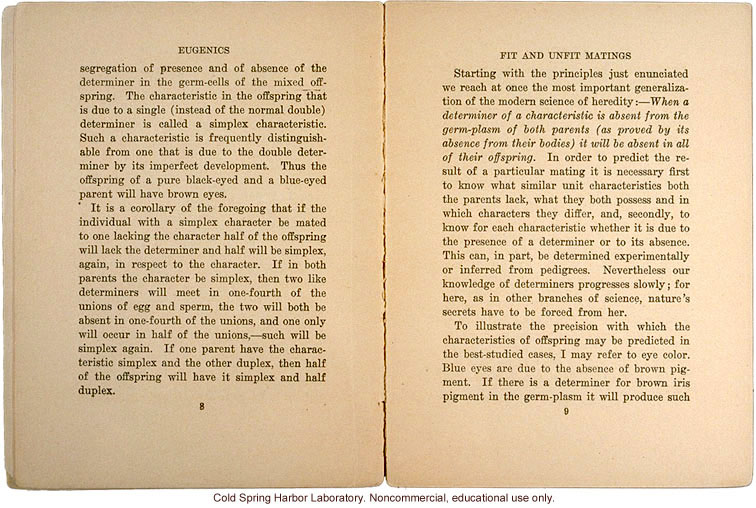Eugenics: The Science of Human Improvement by Better Breeding, by Charles B. Davenport (5)

Eugenics: The Science of Human Improvement by Better Breeding, by Charles B. Davenport (5)
1707. [left side] Eugenics segregation of presence and of absence of the determiner in the germ-cells of the mixed offspring. The characteristic of the offspring that is due to a single (instead of the normal double) determiner is called a simplex characteristic. Such a characteristic is frequently distinguishable from one that is due to the double determiner by its imperfect development. Thus the offspring of a pure black-eyed and a blue-eyed parent will have brown eyes. It is a corollary of the foregoing that if the individual with a simplex character be mated to one lacking the character half of the offspring will lack the determiner and half will be simplex, again, in respect to the character. If in both parents the character be in simplex, then the two like determiners will meet in one-fourth of the unions of egg and sperm, the two will both be absent in one-fourth of the unions, and one only will occur in half of the unions, -- such will be simplex again. If one parent have the characteristic simplex and the other duplex, that half of the offspring will have it simplex and half duplex. 8 [right side] Fit and Unfit Matings Starting with the principles just enunciated we reach at once the most important generalization of the modern science of heredity: -- [italics]When a determiner of a characteristic is absent from the germ-plasm of both parents (as proved by its absence from their bodies) it will be absent in all of their offspring.[end italics] In order to predict the result of a particular mating it is necessary first to know what similar unit characteristics both the parents lack, what they both possess and in which characters they differ, and, secondly, to know for each characteristic whether it is due to the presence of a determiner or to its absence. This can, in part, be determined experimentally or inferred from pedigrees. Nevertheless our knowledge of determiners progresses slowly; for here, as in other branches of science, nature's secrets have to be forced from her. To illustrate the precision with which the characteristics of offspring may be predicted in the best-studied cases, I may refer to eye color. Blue eyes are due to the absence of brown pigment. If there is a determiner for brown iris pigment in the germ-plasm it will produce such 9 [end]
- ID: 11624
- Source: DNALC.EA


